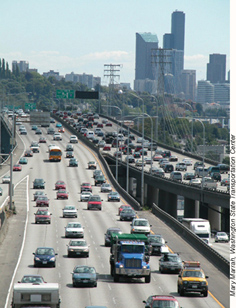A wake-up call to a citizenry in the shadow of oil scarcity

AS THE AMERICAN PUBLIC CONTINUES sleepwalking into a future of energy scarcity, climate change, and geopolitical turmoil, we have also continued dreaming. Our collective dream is one of those super-vivid ones people have just before awakening. It is a particularly American dream on a particularly American theme: how to keep all the cars running by some other means than gasoline. We’ll run them on ethanol! We’ll run them on biodiesel, on synthesized coal liquids, on hydrogen, on methane gas, on electricity, on used French-fry oil … !

The dream goes around in fevered circles as each gasoline replacement is examined and found to be inadequate. But the wish to keep the cars going is so powerful that round and round the dream goes. Ethanol! Biodiesel! Coal liquids …
And a harsh reality indeed awaits us as the full scope of the permanent energy crisis unfolds. According to the U.S. Department of Energy, world oil production peaked in December 2005 at just over 85 million barrels a day. Since then, it has trended absolutely flat at around 84 million. Yet world oil consumption rose consistently from 77 million barrels a day in 2001 to above 85 million so far this year. A clear picture emerges: demand now exceeds world supply. Or, put another way, oil production has not increased despite the ardent wish that it would by all involved, and despite the overwhelming incentive of prices having nearly quadrupled since 2001.
There is no question that we are in trouble with oil. The natural gas situation is comparably ominous, with some differences in the technical details—and by the way, I am referring here to methane gas (CH4), the stuff that fuels kitchen stoves and home furnaces, not cars and trucks. Natural gas doesn’t deplete slowly like oil, following a predictable bell-curve pattern; it simply stops coming out of the ground when a particular gas well is played out. You also tend to get your gas from the continent you are on. To import natural gas from overseas, it has to be liquefied, loaded in a special kind of expensive-to-build-and-operate tanker, and then offloaded at a specialized marine terminal.
Half the homes in America are heated with gas furnaces and about 16 percent of our electricity is made with it. Industry uses natural gas as the primary ingredient in fertilizer, plastics, ink, glue, paint, laundry detergent, insect repellent, and many other common household necessities. Synthetic rubber and man-made fibers like nylon could not be made without the chemicals derived from natural gas. In North America, natural gas production peaked in 1973. We are drilling as fast as we can to keep the air conditioners and furnaces running.
What’s more, the problems of climate change are amplifying, ramifying, and mutually reinforcing the problems associated with rapidly vanishing oil and gas reserves. This was illustrated vividly in 2005, when slightly higher ocean temperatures sent Hurricanes Katrina and Rita slamming into the U.S. Gulf Coast. Almost a year later, roughly 12 percent of oil production and 9.5 percent of natural gas production in the gulf was still out, probably for good. Many of these production platforms may never be rebuilt, because the amounts of oil and gas left beneath them would not justify the cost. If there is $50 million worth of oil down there, why spend $100 million replacing a wrecked platform to get it?

Climate change will also ramify the formidable problems associated with alternative fuels. As I write, the American grain belt is locked in a fierce summer drought. Corn and soybean crops are withering from Minnesota to Illinois; wheat is burning up in the Dakotas and Kansas. Meanwhile, the costs of agricultural “inputs”—from diesel fuel to fertilizers made from natural gas to oil-derived pesticides—have been ramping up steadily since 2003 to the great distress of farmers. Both weather and oil costs are driving our crop yields down, while the industrial mode of farming that has evolved since the Second World War becomes increasingly impractical. We are going to have trouble feeding ourselves in the years ahead, not to mention the many nations who depend for survival on American grain exports. So the idea that we can simply shift millions of acres from food crops to ethanol or biodiesel crops to make fuels for cars represents a staggering misunderstanding of reality.
Still, the widespread wish persists that some combination of alternative fuels will rescue us from this oil and gas predicament and allow us to continue enjoying by some other means what Vice-President Cheney has called the “non-negotiable” American way of life. The truth is that no combination of alternative fuels or systems for using them will allow us to continue running America, or even a substantial fraction of it, the way we have been. We are not going to run Wal-Mart, Walt Disney World, Monsanto, and the Interstate Highway System on any combination of solar or wind energy, hydrogen, ethanol, tar sands, oil shale, methane hydrates, nuclear power, thermal depolymerization, “zero-point” energy, or anything else you can name. We will desperately use many of these things in many ways, but we are likely to be disappointed in what they can actually do for us.
The key to understanding the challenge we face is admitting that we have to comprehensively make other arrangements for all the normal activities of everyday life. I will return to this theme shortly, but first it is important to try to account for the extraordinary amount of delusional thinking that currently dogs our collective ability to think about these problems.
The widespread wish to just uncouple from oil and gas and plug all our complex systems into other energy sources is an interesting and troubling enough phenomenon in its own right to merit some discussion. Perhaps the leading delusion is the notion that energy and technology are one and the same thing, interchangeable. The popular idea, expressed incessantly in the news media, is that if you run out of energy, you just go out and find some “new technology” to keep things running. We’ll learn that this doesn’t comport with reality. For example, commercial airplanes are either going to run on cheap liquid hydrocarbon fuels or we’re not going to have commercial aviation as we have known it. No other energy source is concentrated enough by weight, affordable enough by volume, and abundant enough in supply to do the necessary work to overcome gravity in a loaded airplane, repeated thousands of times each day by airlines around the world. No other way of delivering that energy source besides refined liquid hydrocarbons will allow that commercial system to operate at the scale we are accustomed to. The only reason this system exists is that until now such fuels have been cheap and abundant. We are not going to replace the existing worldwide fleet of airplanes either, and besides, there is no other type of airplane we have yet devised that can work differently.
There may be other ways of moving things above the ground, for instance balloons, blimps, or zeppelin-type airships. But they will move much more slowly and carry far less cargo and human passengers than the airplanes we’ve been enjoying for the past sixty years or so. The most likely scenario in the years ahead is that aviation will become an increasingly expensive, elite activity as the oil age dribbles to a close, and then it will not exist at all.

Another major mistake made by those who fail to pay attention is overlooking the unanticipated consequences of new technology, which more often than not add additional layers of problems to existing ones. In the energy sector, one of the most vivid examples is seen in the short history of the world’s last truly great oil discovery, the North Sea fields between Norway and the UK. They were found in the ’60s, got into production in the late ’70s, and were pumping at full blast in the early ’90s. Then, around 1999, they peaked and are now in extremely steep decline—up to 50 percent a year in the case of some UK fields. The fact that they were drilled with the latest and best new technology turns out to mean that they were drained with stunning efficiency. “New technology” only hastened Britain’s descent into energy poverty. Now, after a twenty-year-long North Sea bonanza in which it enjoyed an orgy of suburbanization, Great Britain is again a net energy importer. Soon the Brits will have no North Sea oil whatsoever and will find themselves below their energy diet of the grim 1950s.
If you really want to understand the U.S. public’s penchant for wishful thinking, consider this: We invested most of our late twentieth-century wealth in a living arrangement with no future. American suburbia represents the greatest misallocation of resources in the history of the world. The far-flung housing subdivisions, commercial highway strips, big-box stores, and all the other furnishings and accessories of extreme car dependence will function poorly, if at all, in an oil-scarce future. Period. This dilemma now entails a powerful psychology of previous investment, which is prompting us to defend our misinvestments desperately, or, at least, preventing us from letting go of our assumptions about their future value. Compounding the disaster is the unfortunate fact that the manic construction of ever more futureless suburbs (a.k.a. the “housing bubble”) has insidiously replaced manufacturing as the basis of our economy.
Meanwhile, the outsourcing of manufacturing to other nations has spurred the development of a “global economy,” which media opinion-leaders such as New York Times columnist Tom Friedman (author of The World Is Flat) say is a permanent state of affairs that we had better get used to. It is probably more accurate to say that the global economy is a set of transient economic relations that have come about because of two fundamental (and transient) conditions: a half century of relative peace between great powers and a half century of cheap and abundant fossil-fuel energy. These two mutually dependent conditions are now liable to come to an end as the great powers enter a bitter contest over the world’s remaining energy resources, and the world is actually apt to become a lot larger and less flat as these economic relations unravel.
This is approximately the state of the nation right now. It is deeply and tragically ironic that the more information that bombards us, the less we seem to understand. There are cable TV news networks and Internet news sites beyond counting, yet we are unable to process this deluge of information into a coherent public discussion about the fundamental challenges that our civilization faces—not to mention a sensible agenda for meeting these hardships. Meanwhile, CBS News tells millions of viewers that the tar sands of Alberta will solve all our problems, or (two weeks later) that the coal beds under Montana and Wyoming will sustain business as usual, and CNN tells another several million viewers that we can run everything here on ethanol, just like they do in Brazil.
Of course, the single worst impediment to clear thinking among most individuals and organizations in America today is the obsession with keeping the cars running at all costs. Even the environmental community is guilty of this. The esteemed Rocky Mountain Institute ran a project for a decade to design and develop a “hyper-car” capable of getting supernaturally fabulous mileage, in the belief that this would be an ecological benefit. The short-sightedness of this venture? It only promoted the idea that we could continue to be a car-dependent society; the project barely gave nodding recognition to the value of walkable communities and public transit.
The most arrant case of collective cluelessness now on view is our failure to even begin a public discussion about fixing the U.S. passenger railroad system, which has become so decrepit that the Bulgarians would be ashamed of it. It’s the one thing we could do right away that would have a substantial impact on our oil use. The infrastructure is still out there, rusting in the rain, waiting to be fixed. The restoration of it would employ hundreds of thousands of Americans at all levels of meaningful work. The fact that we are hardly even talking about it—at any point along the political spectrum, left, right, or center—shows how fundamentally un-serious we are.

This is just not good enough. It is not worthy of our history, our heritage, or the sacrifices that our ancestors made. It is wholly incompatible with anything describable as our collective responsibility to the future.
We have to do better. We have to start right away making those other arrangements. We have to begin the transition to some mode of living that will allow us to carry on the project of civilization—and I would argue against the notion advanced by Daniel Quinn and others that civilization itself is our enemy and should not be continued. The agenda for facing our problems squarely can, in fact, be described with some precision. We have to make other arrangements for the basic activities of everyday life.
In general, the circumstances we face with energy and climate change will require us to live much more locally, probably profoundly and intensely so. We have to grow more of our food locally, on a smaller scale than we do now, with fewer artificial “inputs,” and probably with more human and animal labor. Farming may come closer to the center of our national economic life than it has been within the memory of anyone alive now. These changes are also likely to revive a menu of social and class conflicts that we also thought we had left behind.
We’ll have to reorganize retail trade by rebuilding networks of local economic interdependence. The rise of national chain retail business was an emergent, self-organizing response to the conditions of the late twentieth century. Those conditions are now coming to an end, and the Wal-Mart way of doing business will come to an end with them: the twelve-thousand-mile merchandise supply line to Asian factories; the “warehouse on wheels” made up of thousands of tractor-trailer trucks circulating endlessly between the container-ship ports and the big-box store loading docks. The damage to local economies that the “superstores” leave behind is massive. Not only have they destroyed multilayered local networks for making and selling things, they destroyed the middle classes that ran them, and in so doing they destroyed the cultural and economic fabric of the communities themselves. This is a lot to overcome. We will have to resume making some things for ourselves again, and moving them through smaller-scale trade networks. We may have fewer things to buy overall. The retail frenzy of recent decades will subside as we struggle to produce things of value and necessarily consume less.
We’ll have to make other arrangements for transporting people and goods. Not only do we desperately need to rebuild the railroad system, but electrifying it—as virtually all other advanced nations have done—will bring added advantages, since we will be able to run it on a range of things other than fossil fuels. We should anticipate a revival of maritime trade on the regional scale, with more use of boats on rivers, canals, and waterways within the U.S. Many of our derelict riverfronts and the dying ports of the Great Lakes may come back to life. If we use trucks at all to move things, it will be for the very last leg of the journey. The automobile will be a diminishing presence in our lives and, increasingly, a luxury that will be resented by those who can no longer afford to participate in the “happy motoring” utopia. The interstate highways themselves will require more resources to maintain than we will be able to muster. For many of us, the twenty-first century will be less about incessant mobility than about staying where we are.
We have to inhabit the terrain of North America differently, meaning a return to traditional cities, towns, neighborhoods, and a productive rural landscape that is more than just strictly scenic or recreational. We will probably see a reversal of the two-hundred-year-long trend of people moving from the country and small towns to the big cities. In fact, our big cities will probably contract substantially, even while they re-densify at their centers and along their waterfronts. The work of the New Urbanists will be crucial in rebuilding human habitats that have a future. Their achievement so far has been not so much in building “new towns” like Seaside, Florida, or Kentlands, Maryland, but in retrieving a body of knowledge, principle, and methodology for urban design that had been thrown away in our mad effort to build the drive-in suburbs.
It is harder to predict exactly what may happen with education and medicine, except to say that neither can continue to operate as rackets much longer, and that they, like everything else, will have to become smaller in scale and much more local. Our centralized school districts, utterly dependent on the countless daily trips of fleets of yellow buses and oppressive property taxes, have poor prospects for carrying on successfully in an energy-scarce economy. However, we will be a less affluent nation in the post-oil age, and therefore may be hard-pressed to replace them. A new, more locally based education system may arise instead out of home-schooling, as household classes aggregate into new, small, neighborhood schools. College will cease to be a mass-consumer activity, and may only be available to social elites—if it continues to exist at all. Meanwhile, we’re in for a pretty stark era of triage as the vast resources of the “medical industry” contract. Even without a global energy crisis bearing down on us, the federal Medicaid and Medicare systems would not survive the future as currently funded.
As a matter of fact, you can state categorically that anything organized on a gigantic scale, whether it is a federal government or the Acme Corporation or the University of Michigan, will probably falter in the energy-scarce future. Therefore, don’t pin your hopes on multinational corporations, international NGOs, or any other giant organizations or institutions.
Recent events have caused many of us to fear that we are headed toward a Big Brother kind of governmental tyranny. I think we will be lucky if the federal government can answer the phones, let alone regulate anyone’s life, in the post-oil era. As power devolves to the local and regional level, the very purpose of our federal arrangements may come into question. The state governments, with their enormous bureaucracies, may not be better off. Further along in this century, the real political action will likely shift down to the local level, as reconstructed neighborly associations allow people to tackle problems locally with local solutions.
It’s a daunting agenda, all right. And some of you are probably wondering how you are supposed to remain hopeful in the face of these enormous tasks. Here’s the plain truth, folks: Hope is not a consumer product. You have to generate your own hope. You do that by demonstrating to yourself that you are brave enough to face reality and competent enough to deal with the circumstances that it presents. How we will manage to uphold a decent society in the face of extraordinary change will depend on our creativity, our generosity, and our kindness, and I am confident that we can find these resources within our own hearts, and collectively in our communities.
For more information on this article and the authors please visit: Orion Magazine website and David Maisel’s website.
You can return to the main Market News page, or press the Back button on your browser.

